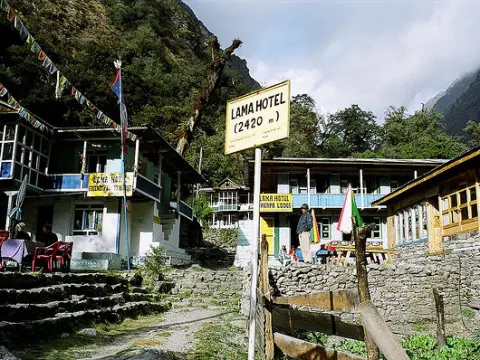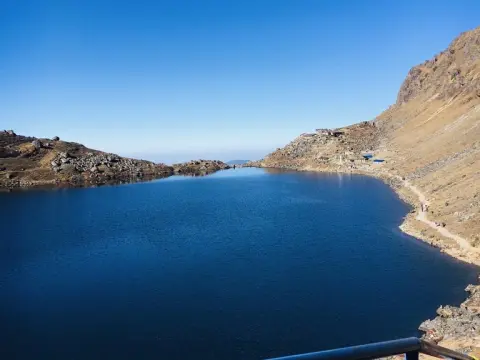Lama Hotel: An Ideal Stop In Langtang Valley
IntroductionLama Hotel is a small Nepali settlement in the Langtang Valley in Nepal. It is located at an elevation of around 2470 meters above sea lev...


Langtang Village is a picturesque village in the middle of Langtang Valley, Nepal. The village stands at an elevation of 3,430 meters above sea level surrounded by towering peaks. Langtang Village is famous for its centuries-old Tibetan culture and stunning mountain views. Trekkers to Langtang Village experience local hospitality and calm natural beauty.
Furthermore, Langtang Village is a regular acclimatization stop for the Langtang Valley Trek. The village is located near the Langtang River and at the foot of Langtang Lirung, a massive 7,227-meter peak. Because of its elevation, visitors can slowly acclimatize. It is therefore an ideal resting area before proceeding with the trek.
Moreover, the village was badly damaged during the earthquake in 2015 but has been rebuilt since. The locals worked hard to reconstruct their homes, teahouses, and temples. Langtang Village now welcomes trekkers with cheerful smiles and safe lodging. Its resilience and re-emergence are symbolic of the region's spirit.
There are also several tea houses, some shops, and a monastery in the village. Trekkers typically visit cultural sites like the village gompa and prayer wheels. The cultural experiences add depth to the trekking experience. The combination of nature and culture is what makes Langtang Village unique.
In short, Langtang Village is a significantly important cultural and natural hub along the trek. Its high altitude, welcoming inhabitants, and breathtaking landscape attract a multitude of trekkers annually. Therefore, it remains an attraction not to be missed in Langtang National Park. The village provides a lingering Himalayan experience and cultural insight.
To begin with, Langtang Village is found in Langtang Valley in Rasuwa District, Nepal. It stands at an altitude of 3,430 meters above sea level. The village is surrounded by lofty peaks like Langtang Lirung, which stands at 7,227 meters tall. The mountains tower over the sky and provide breathtaking scenery for trekkers.
Besides, the village stands along the banks of the Langtang River, which flows through the valley. Fresh water from the river supports local agriculture and daily life. Likewise, the area consists of a mix of alpine meadows, forests, and rocky hills. There are rhododendron and fir trees common around the village.
Additionally, Langtang Village is also near the Langtang Glacier, which is a significant glacial landform. The glacier drains into the Langtang River and shapes the surrounding terrain. Such geographic location exposes the village to harsh cold mountain winds and snow in winter. Therefore, the climate can be harsh but scenic.
Furthermore, the village connects the lower Langtang trail to the high points like Kyanjin Gompa (3,870 meters). It is a base for trekkers to explore nearby peaks and natural sights. Trails from Langtang Village lead to secluded valleys, glaciers, and mountain passes. These make it a hub for adventure.
In total, the environment of Langtang Village is of stunning natural beauty with strategic trail access. The geography and elevation of the village shape its unique character. Because of this, it remains a trekkers' and nature lovers' top choice. The river, forest, glacier, and peaks combine to create an indelible Himalayan experience.
To begin with, Langtang Village is accessible on foot only, located far inside the Himalayas. Trekkers normally start the trek from Syabrubesi, which stands at 1,460 meters. It takes about 5 to 7 hours to reach the village from there. The trail rises gradually through forests and tiny villages, giving good views.
Moreover, there are no vehicles or roads that directly go to Langtang Village. The nearest road access is as far as Syabrubesi. It takes about 7 to 8 hours from Kathmandu to get to Syabrubesi via bus or jeep. The road is unpaved but generally open year-round except during landslides. The journey therefore requires patience and good planning.
Likewise, helicopters can also be chartered for emergency or special visits. This is expensive and not so common. Most trekkers prefer to walk for acclimatization and experience. The trekking route is well-marked and well-maintained by the local administration. Guides and porters are readily available to assist trekkers along the route.
In addition, mobile phone network signals are limited but often available up to Langtang Village. Internet is slow and unreliable but sufficient for communications. Electricity is supplied mainly by solar panels or small generators in the village. This offers the potential for charging devices at teahouses, usually for a small fee.In short, Langtang Village is quite accessible via trekking routes starting from Syabrubesi. There is no direct road, but the path is safe and frequented. The journey entails a combination of rough road travel and scenic hiking. This makes Langtang Village a rewarding destination for adventure seekers. Trekkers are treated to natural beauty and cultural richness on arrival.
To start with, Langtang Village has necessary amenities for trekkers along the Langtang route. There are tea houses that serve as accommodation and restaurants. Rooms are simple but clean, with warm blankets. This makes resting comfortably after a day of much walking. There is electricity available mostly from solar power.
Meanwhile, there are also traditional Nepali dishes like dal bhat, noodles, and soups. Tea and coffee are served as hot drinks throughout the day. Snacks and bottled water are easily accessible to visitors. All of these helps to keep trekkers fed and refreshed. Basic kitchens and dining halls are what most tea houses have.
Moreover, toilets are also shared in general and are located outside rooms. Hot showers can be had but at an extra cost. Water is heated using gas or solar panels. Hot showers are subject to the weather and availability. Most trekkers, nevertheless, manage to clean themselves in comfort.
Also, there is electronic device charging at a small fee. Mobile phone reception is limited but superior to that of lower villages. There is Wi-Fi in certain tea houses, even though it is slow. Trekkers need to be well-prepared for limited connectivity and bring power banks. Despite these limitations, the village is well-stocked.
Overall, Langtang Village provides useful and welcoming facilities to trekkers. Though basic, the facilities cater to basic needs well. Shelter, food, and charging points make for a comfortable visit. The facilities in the village allow trekkers to acclimatize and prepare for the next higher elevation. Langtang Village is thus an important overnight halt on the trek.
To start with, Langtang Village is famous for its stunning mountain views. The village itself lies beneath Langtang Lirung, a giant mountain that towers at 7,227 meters. The panoramic mountain looms over the skyline and impresses every guest. Trekkers enjoy captivating sunrise and sunset here.
Moreover, the village is surrounded by thick rhododendron and oak forests. Rhododendrons bloom in spring with bright red and pink flowers. The scenic beauty of the location makes the place a paradise for photographers and nature lovers. The fauna, comprising langurs and Himalayan birds, also add to the beauty of the location.
Likewise, Langtang Village is full of Tibetan culture. Its residents follow Buddhism and maintain ancient monasteries. Trekkers can explore gompas, prayer wheels, and mani stones scattered around. These cultural monuments offer an insight into the local way of life. Festivals and rituals observed here attract many trekkers.
In addition, Langtang National Park's biodiversity is a major attraction. The park is home to such rare animals as red pandas and musk deer. While actual sightings are rare, trekkers enjoy spotting signs and footprints. Birdwatching is also popular with birds like Himalayan monal and pheasants.
Lastly, Langtang Village combines natural beauty with cultural importance. The environment offers panoramic mountain views and greenery. The cultural attractions increase appreciation for local culture. These activities cumulatively render Langtang Village an unforgettable experience on the trek. Accordingly, it is one of the most frequented Himalayan villages.
Most importantly, trekking is the main activity of Langtang Village. Trekkers stay overnight here before heading further to Kyanjin Gompa or any other altitude. The village itself is a perfect acclimatization stop at 3,430 meters. Hence, hikers undertake short hikes around to adjust altitude gradually.
Additionally, nature walks around the village are done. The routes go through oak and rhododendron forests. There is bright flowering in spring, and the views are scenic. Birdwatching is done with many Himalayan species being spotted. The serene environment and fresh mountain air are enjoyed by trekkers.
Likewise, exploring local culture is another activity. Trekkers can visit monasteries, observe prayer wheels, and meet warm people. Traditional Buddhist practices offer an insight into the region's history. From time to time, there are festivals and rituals, which attract visitors. These cultural elements add to the trekking adventure.
Also, photography is a popular activity. The picturesque mountain background and lush forests make for great photography. The light at sunrise and sunset adds to the beauty of nature. Most trekkers take photos of wildlife, scenery, and village life. The activity serves as a good way to keep memories of Langtang Village alive.
Briefly, Langtang Village offers a number of activities for visitors. Be it trekking and hiking or cultural tours and photography, something is there for everyone. The peaceful atmosphere of the village offers the best setting for rest and reflection. So, trekkers tend to spend extra days here before heading further up. Langtang Village surely enriches the Himalayan trek.
To begin with, Langtang Village is crucial for trekkers to acclimate. It stands at 3,430 meters above sea level and allows gradual high-altitude adaptation. This prevents altitude sickness during higher climbs. Therefore, the majority of trekkers rest here prior to advancing. The village is a safe halt along the challenging trek.
Additionally, Langtang Village maintains rich Tibetan culture and traditions. Residents practice Buddhism and maintain gompas and prayer wheels. Trekkers get to see traditional mountain community life and religious practices. This cultural experience enriches the trekking experience immensely. Trekkers learn about the region's unique heritage here.
In addition, the village serves as an entry point to the nearby natural wonders. Trekkers have access to alpine meadows, glaciers, and high passes from Langtang. The environs of Langtang Lirung peak, standing at 7,227 meters, offer room for adventure. Langtang Village is thus a significant expedition base. It connects hikers with the beautiful Himalayan landscape.
Besides, the village symbolizes resilience after the 2015 earthquake devastation. Individuals rebuilt homes, lodges, and cultural sites meticulously. The recovery reflects the strength and spirit of the locals. It inspires tourists and promotes sustainable tourism in fragile mountain areas. Langtang Village is a source of inspiration.
In summary, Langtang Village is significant in several ways. It facilitates secure acclimatization for trekkers on the Langtang trail. It saves Tibetan culture and traditions richly. It acts as a gateway to incredible nature and adventure. Finally, it symbolizes the strength of Himalayan people. Therefore, Langtang Village is an integral component of every trekker's experience.
To start with, Langtang Village provides a number of cozy tea houses for trekkers. These lodges have simple rooms with warm blankets. The majority of the rooms consist of twin beds and clean beddings. Due to high altitude, rooms remain cold, and hence blankets are necessary. Electricity is provided mainly through solar panels.
Also, there are hot showers available at most tea houses at an extra charge. Water is either solar or gas heated. Availability, nevertheless, depends on weather and water conditions. Despite that, showers are deemed revitalizing by a majority of trekkers following days of long treks. Bathrooms are generally shared and basic but clean.
Likewise, tea houses provide delicious Nepali and Tibetan food. Dal bhat, noodles, momos, and soups are popular. Tea, coffee, and lemon honey tea are some hot drinks that help to warm the body. Snacks and bottled water are also sold in most lodges. All these provide trekkers with the energy required to move forward.
Additionally, one can charge electronic devices at most of the lodges for a small fee. There is mobile network and slow Wi-Fi in the village but not necessarily reliable. It is advised that trekkers carry power banks for convenience. Local guides and porters also use the tea houses.
Overall, the lodging in Langtang Village meets the needs of most trekkers. The tea houses offer basic but clean accommodation, hot meals, and some modern amenities. This makes the village a cozy resting place at 3,430 meters. So, trekkers find Langtang Village to be a warm stopover during their Himalayan trek.


IntroductionLama Hotel is a small Nepali settlement in the Langtang Valley in Nepal. It is located at an elevation of around 2470 meters above sea lev...

IntroductionGosainkunda is one of Nepal's Langtang region's sacred alpine lakes. It is situated at 4,380 meters above sea level. Due to its religious...

IntroductionGhoda Tabela is a peaceful resting place in the Langtang Valley. It lies within Langtang National Park in Nepal at an elevation of 3,0...
